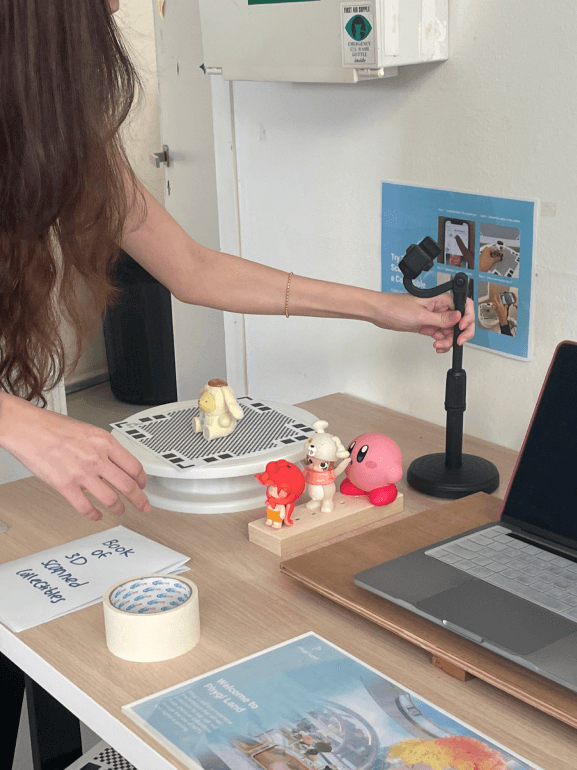Week 12 - 15
Our open studio is on Week 12 and I have to prepare the necessary materials to showcase my project. It is fun to consider the visual aesthetics of my setup and effectively showcase my project to visitors who are not familiar with the topic. From week 12 - 15, conducting user testing and refining my work is of utmost importance. This critical phase will enable me to gather valuable feedback from users and make necessary adjustments to improve the quality of my project.
WEEK 12 - OPEN STUDIO
Preparation
To prepare for week 12, I have planned to use various tools and equipment to showcase my project effectively. These include a projector to display the user's view through the VR headset, an iMac to showcase the virtual world, 3D scanning tools to demonstrate how to scan objects, a publication book featuring 3D scanned collectibles, and some physical collectibles for demonstration. Additionally, I will use an iPad to show a video that demonstrates how the metaverse looks like. This is my first time setting up, it's crucial to figure out the most effective way to present my work. Therefore, I make some changes along the way during week 12 to ensure that I can display my project in the most effective manner possible.


Some challenges that I faced during week 12
While preparing for week 12, I encounter some problems but I managed to overcome it in time for the open studio.
1. Restriction of space
Initially, I planned to position the chair in front of my table to enable people to try out the VR experience. However, I later realized that the distance between the chair and the table was too close, and people might accidentally bump into each other. As a result, I need to be aware of the space limitations and make necessary adjustments to ensure a safe and comfortable experience for my audience.
2. Equipment
Initially, due to the amount of equipment required, we did not have an iMac available for use. Fortunately, I was able to acquire one just before week 12. However, the iMac was quite old, which resulted in a slower FPS (frames per second) and decreased the overall quality of the experience. Additionally, the school's WiFi was not very fast, which further impacted the speed of the iMac. Despite these challenges, the VR headset was a good alternative to provided a unique and immersive experience that cannot be replicated on a regular computer.
Physical to Digital
This particular segment of my project is crucial for explaining to individuals who may not fully understand my project. During week 12, I demonstrates how physical assets can be digitized using 3D scanning technology. I spent considerable time engaging with visitors and providing demonstrations of the 3D scanning process. I also showcased how the digitized assets appeared within my metaverse, which surprised many users who were able to see both the physical and digital versions of the collectibles. Based on my interactions with these individuals, I observed that they were impressed by the link between the physical and digital collectibles. To further engage them, I also provided an alternative for those who were keen on 3D scanning and encouraged them to download the software and scan their own assets. These experiences ultimately led to my final project setup, which involved displaying physical collectibles on the left side and transitioning to digital assets, followed by the metaverse display.

Before

After

In the initial setup, I printed the information on A4 paper, which turned out to be too small for people to read. As a result, I made some adjustments to the final setup by printing on A3 mounting board. This change helped to improve the visibility of the information and make it easier for visitors to understand my project. To further enhance the visitor experience, I prepared three display boards, which explained how to scan the collectibles, provided an overview of the project, and showcased the world with the floor plan. A few days before the event, I also completed a publication book to showcase all 50 3D scanned collectibles, which was effectively displayed in the metaverse through the iMac as shown on the right side of my final setup. Overall, these changes greatly improved the overall presentation and helped visitors to better understand the scope and vision of my project.

User testing
During the feedback session, I gathered insights and suggestions from a group of 30 participants who were mostly between the ages of 18 and 28 years old. Their feedback was crucial in helping me refine the project for the final presentation in week 16.







